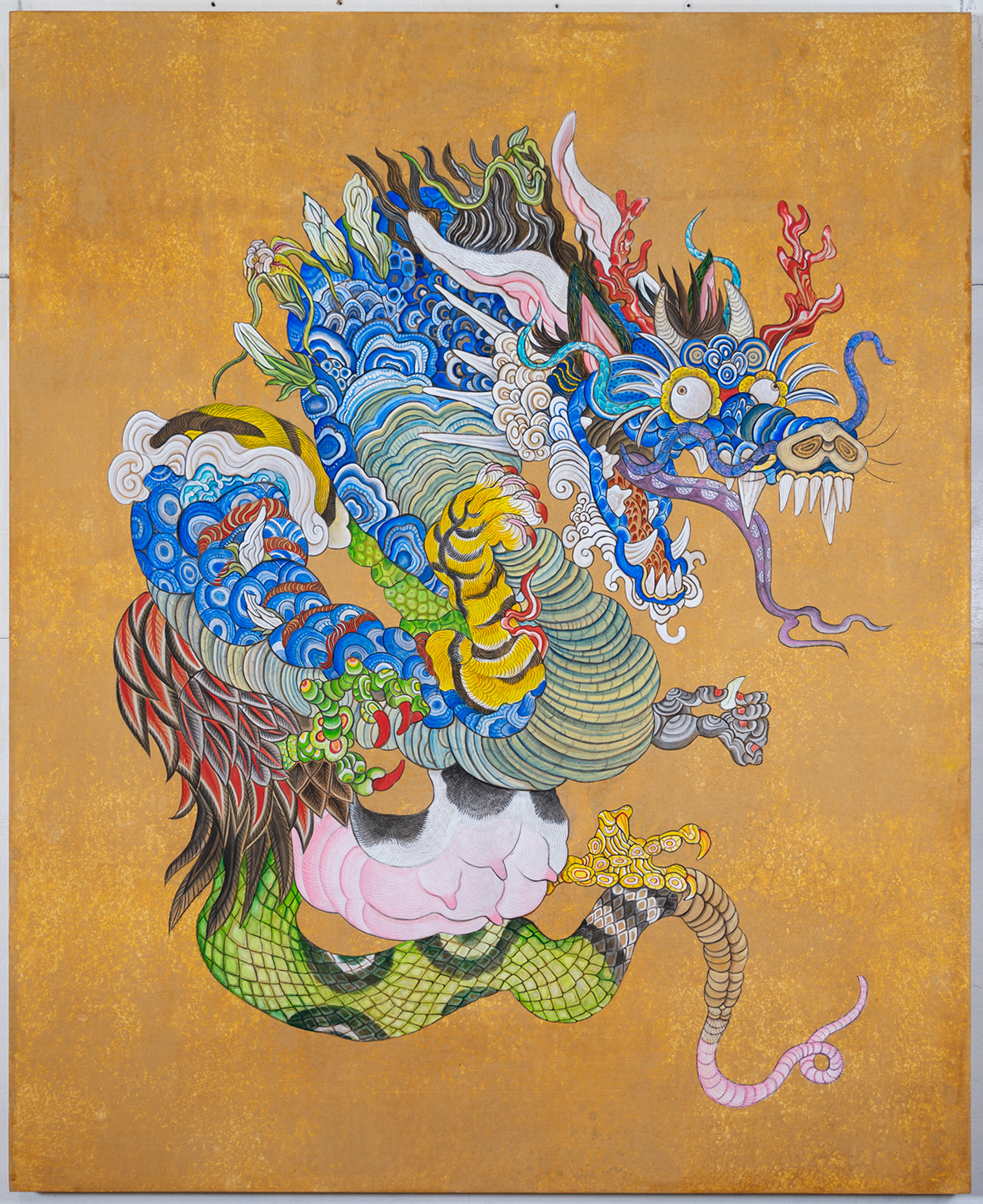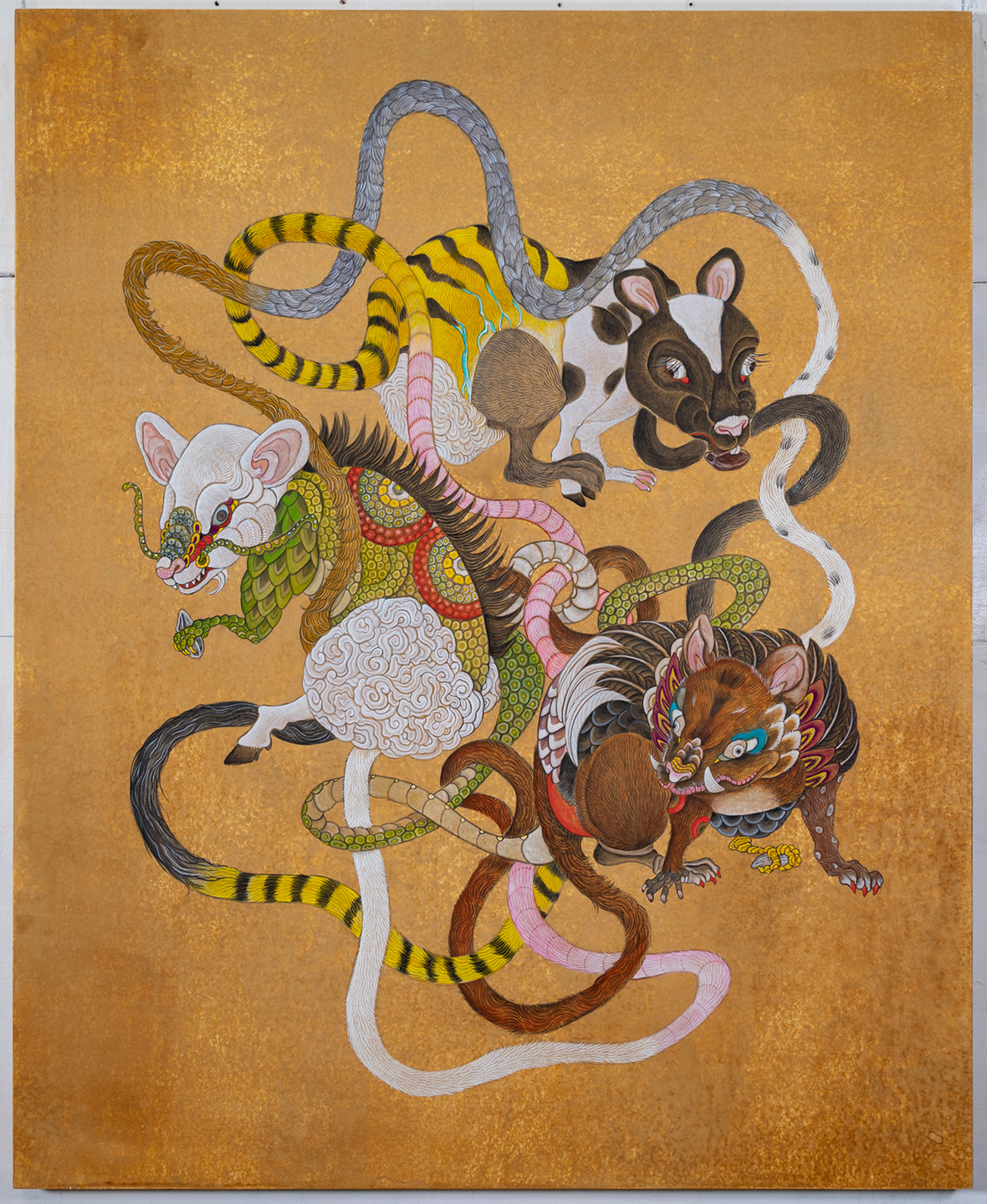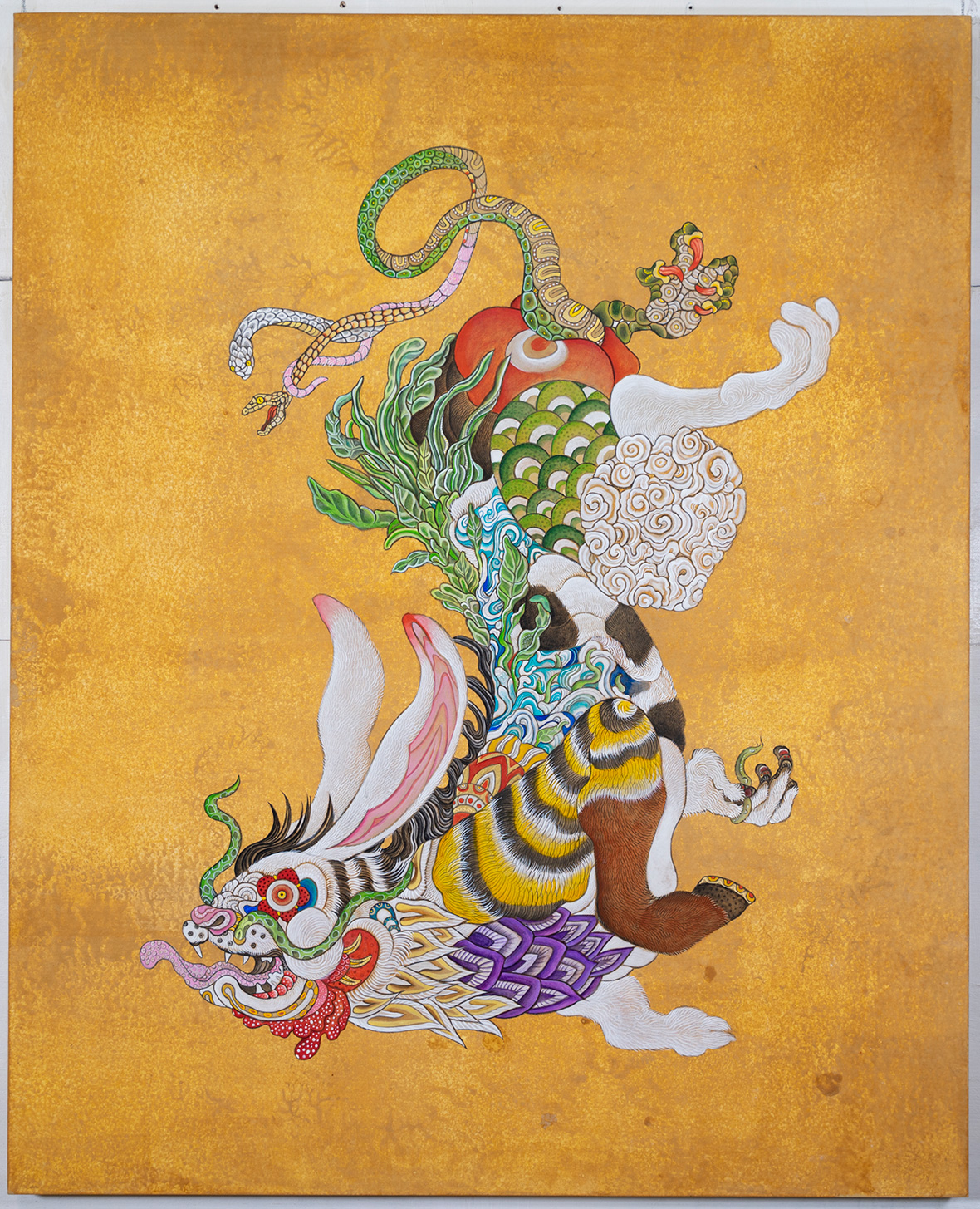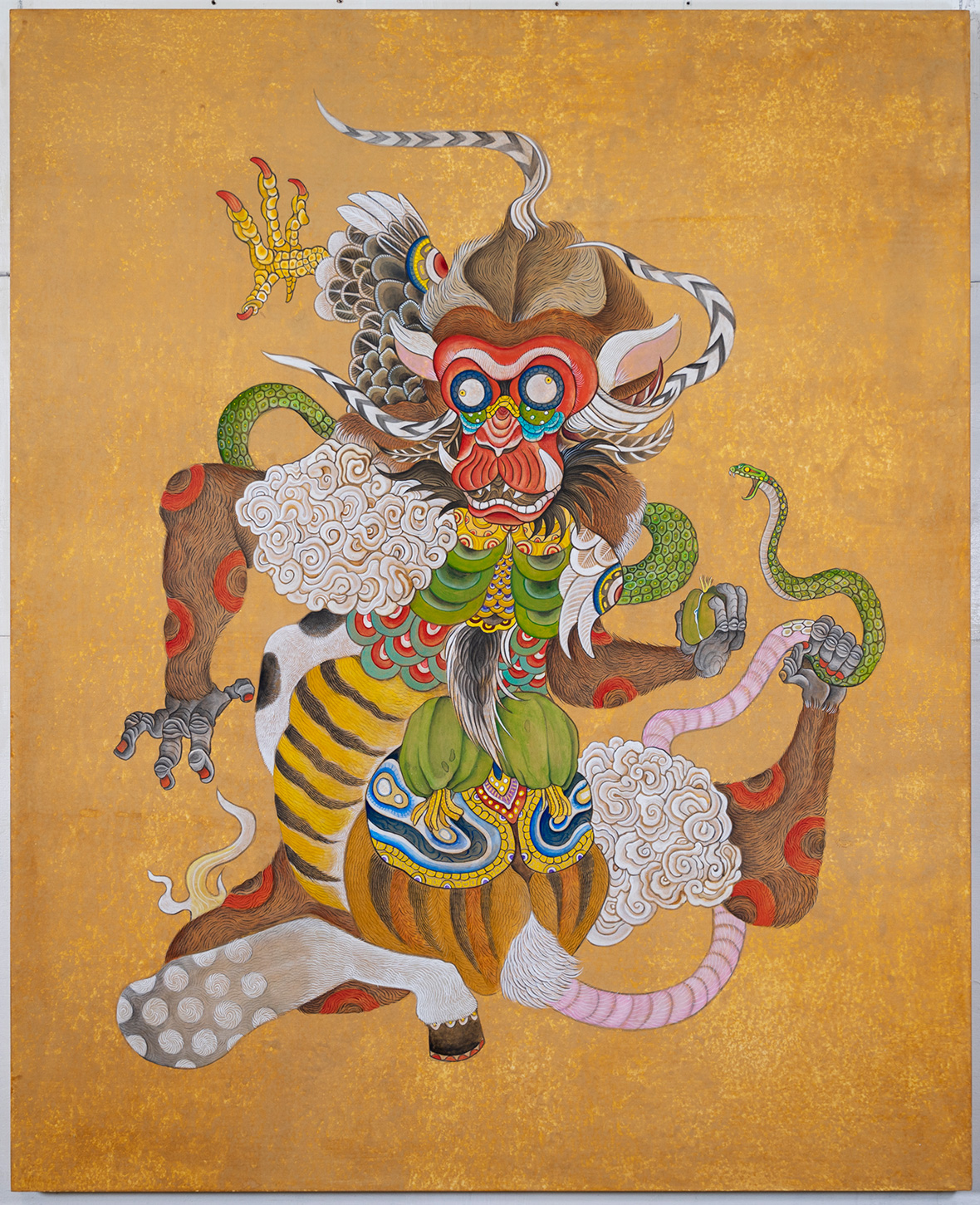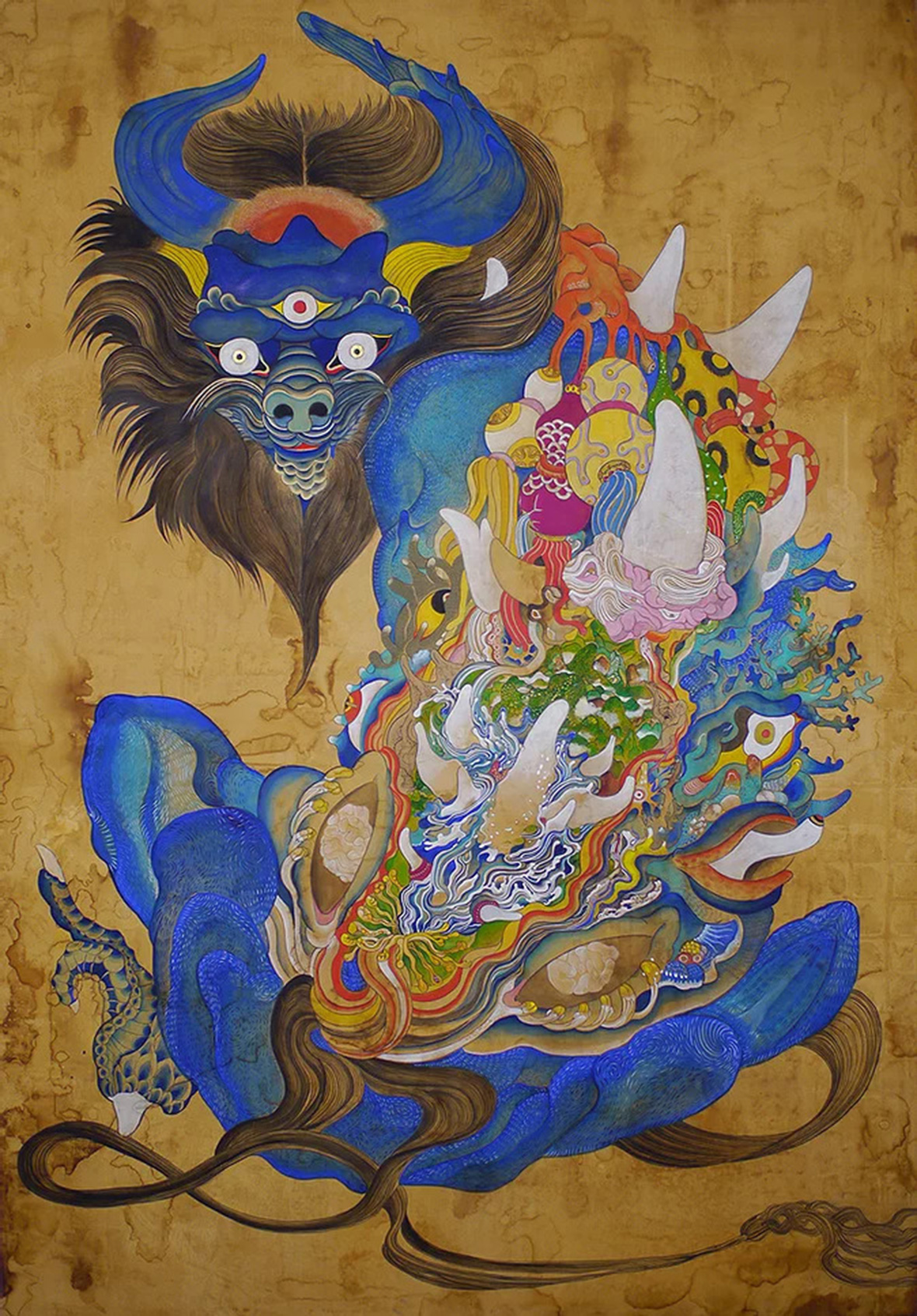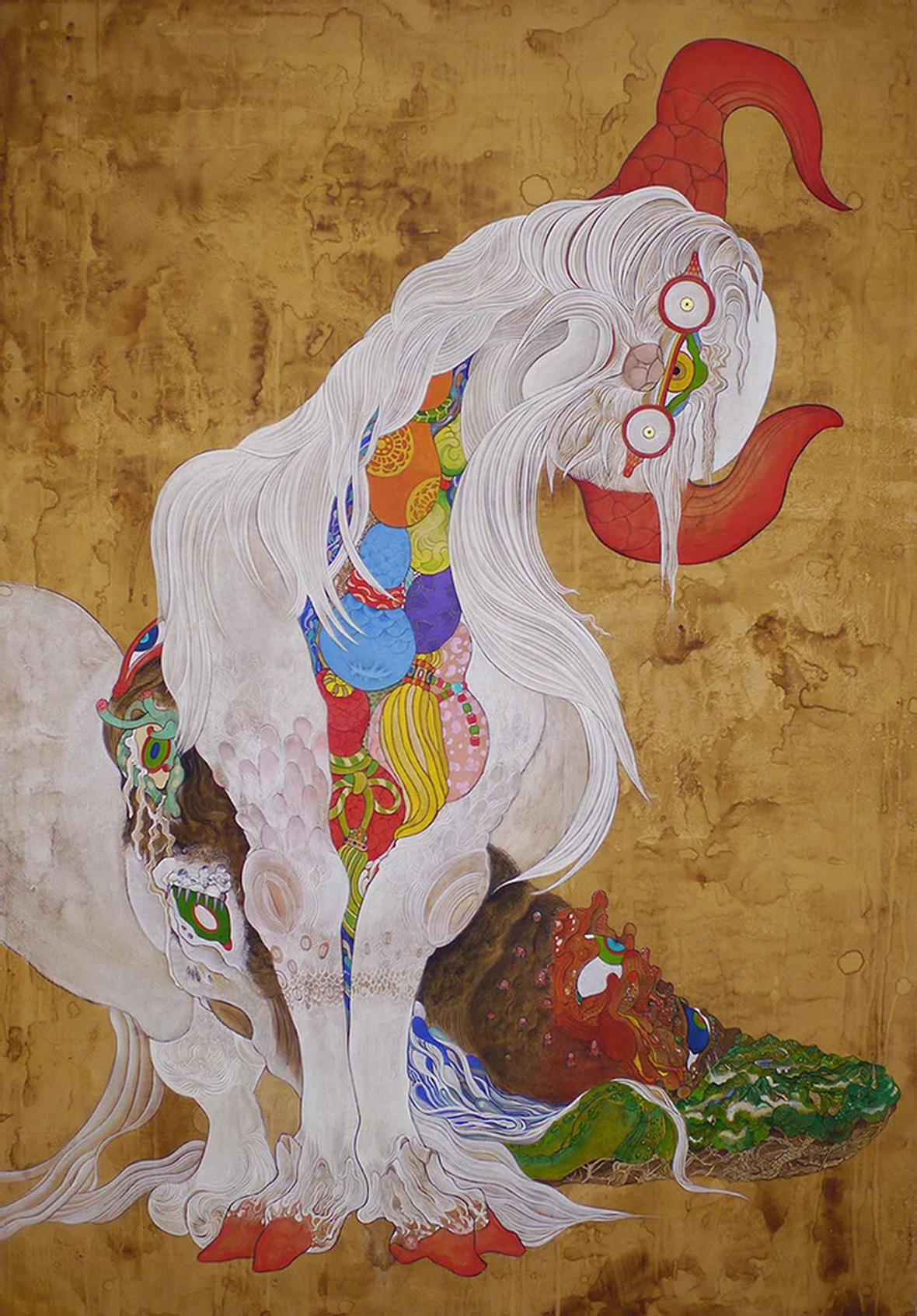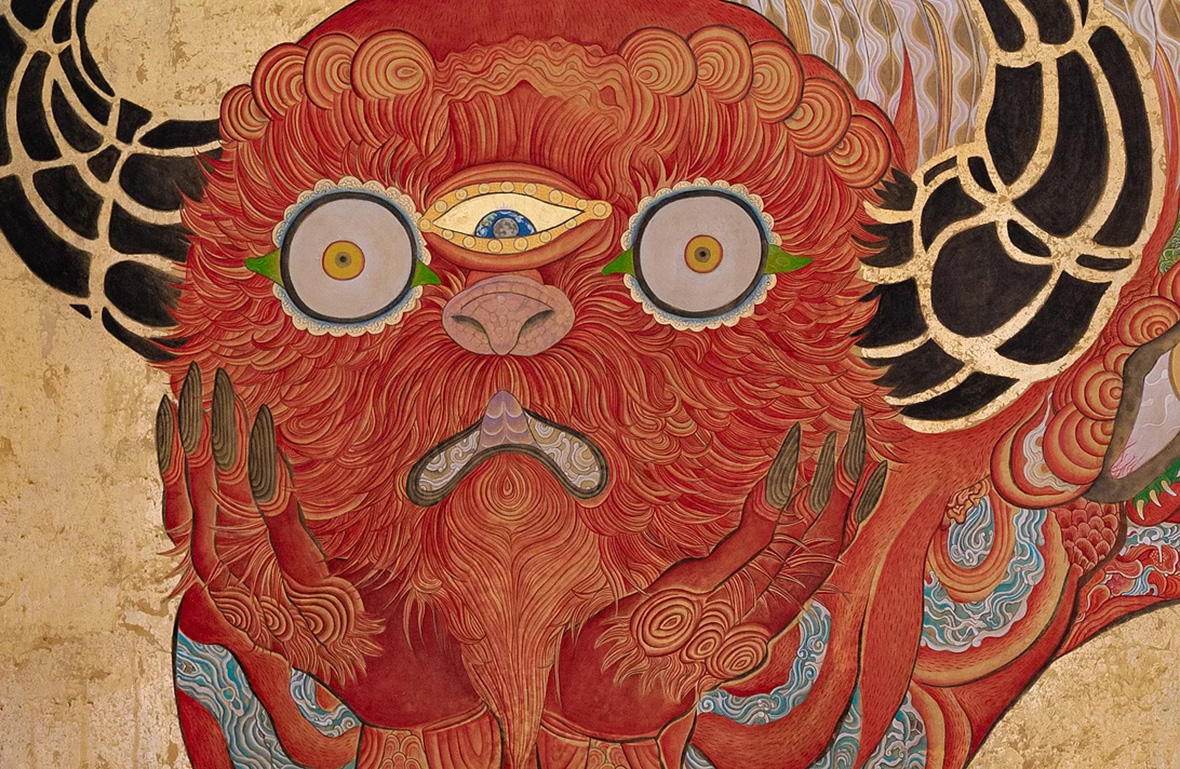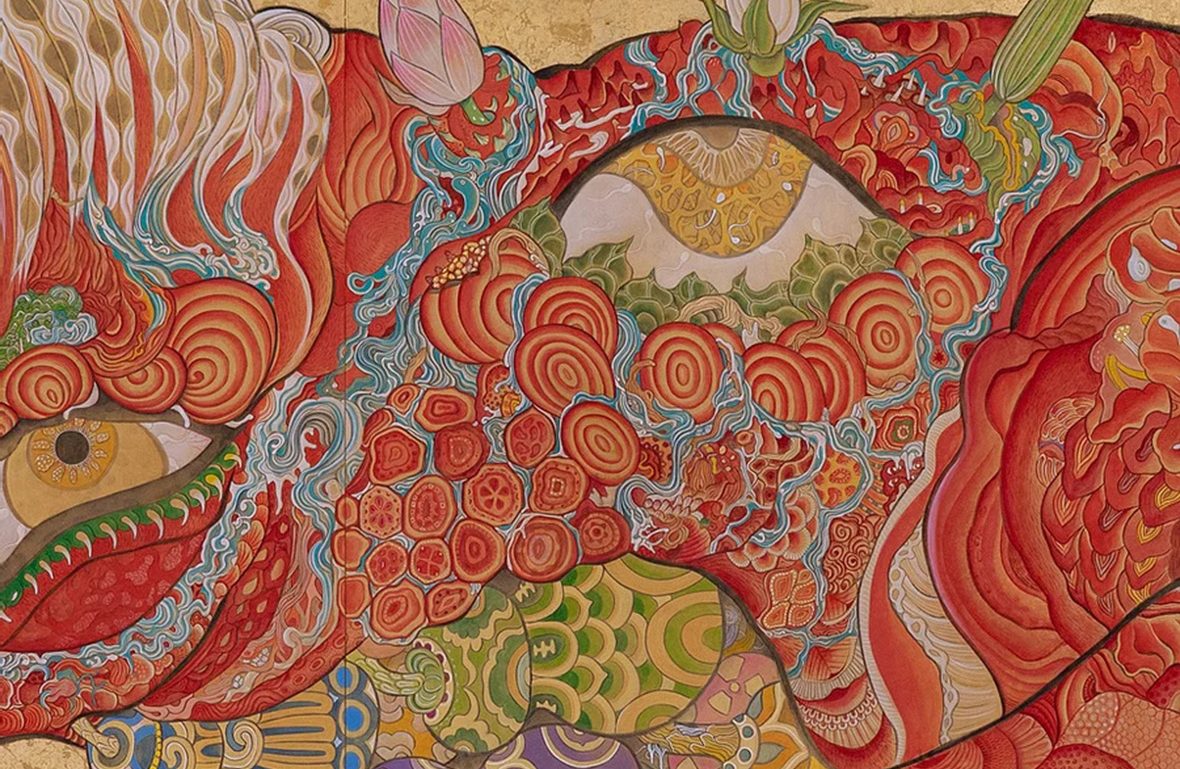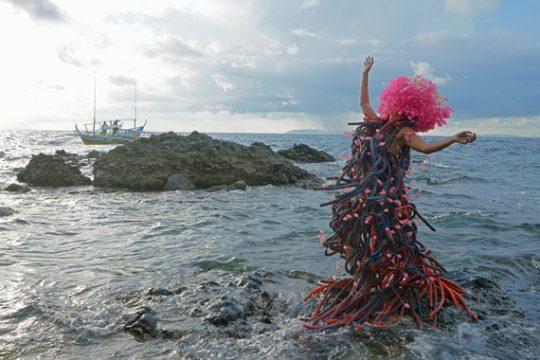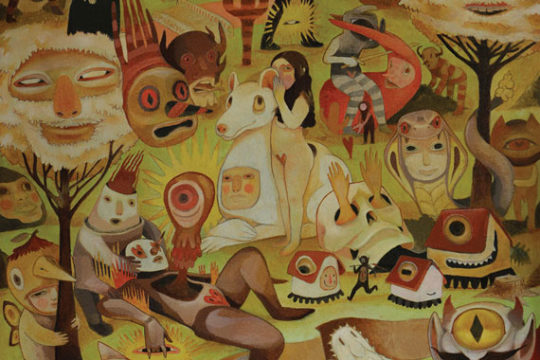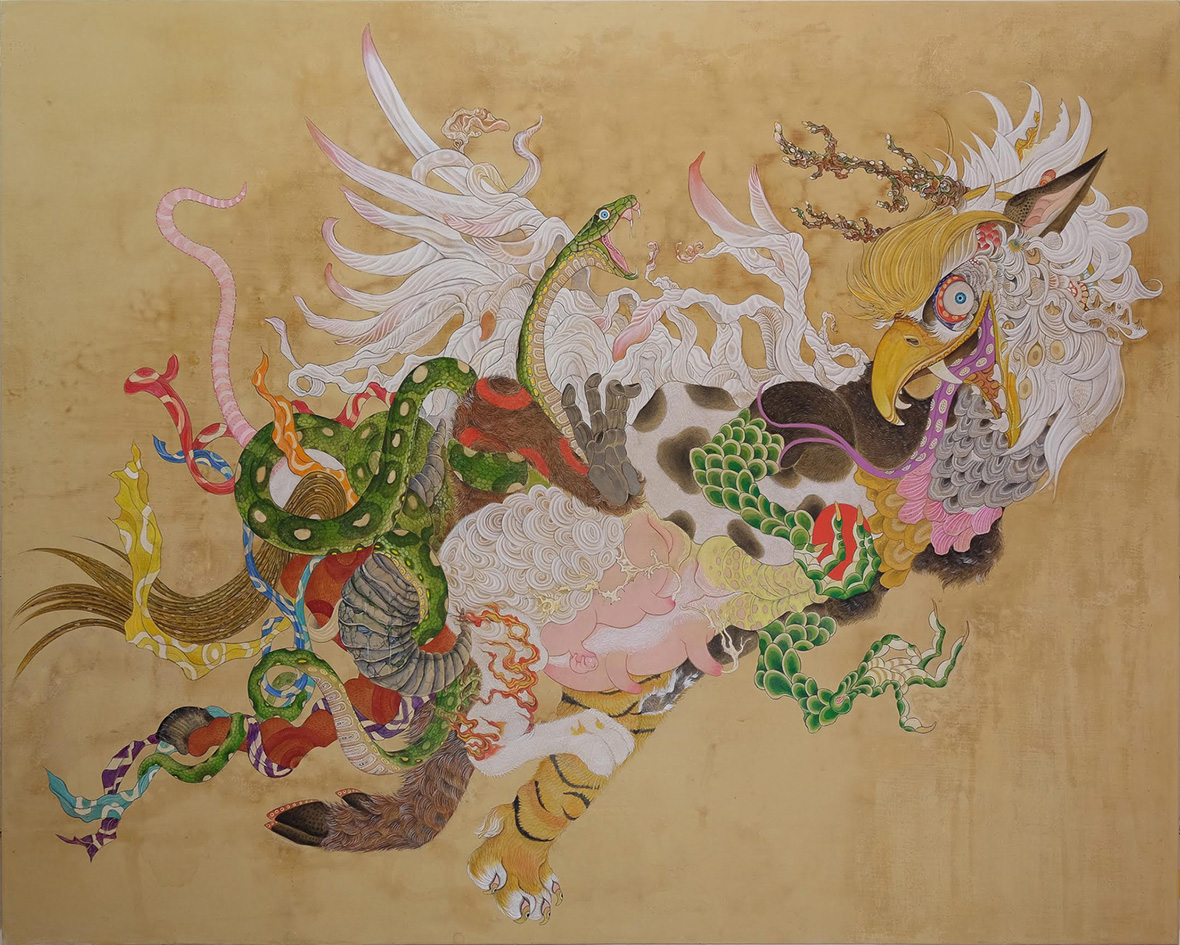
The paintings of feebee are rooted in classical Japanese tradition. They’re a window for learning the lessons of a tumultuous past, but they’re also comforting—in that they illustrate the strife of today is not entirely unique. In her work, mythical creatures in brilliant colors float on blank expanses of gold and earthen tones. They fly and thrash about in confusion or anger, sometimes eating or preening themselves, other times enraged or gazing at something out of frame.
日本艺术家 feebee 的绘画植根于日本古典传统,既提供了一个了解过往动荡历史的窗口,又能安抚人心——在一定程度上它们也是一种借鉴,告诉人们现今的世界冲突,也并非什么新鲜事。在她的作品中,色彩艳丽的神话生物漂浮于金色或大地色调的背景之上,因慌乱或愤怒而横冲直撞;时而在进食,时而在整理毛发,时而看上去怒气冲冲,又像是凝视着画面之外的什么东西。
feebee’s newest series is the Cycle of Transformation, a collection of twelve paintings depicting each animal from the zodiac calendar in chimeric form. These hybrid creatures are representations of conflict and coexistence. “I view the phenomena in our world to be part of a large cycle,” the self-taught artist from Kanagawa prefecture says, “and I’m interested in exploring how we can interact with it to create a better cycle for the next generation through my work.” The zodiac animals were introduced by China to Japan sometime around the 500s or 600s. “They represent the cycle that has existed since time immemorial, changing but repeating throughout the ages.”
feebee 最新系列《Cycle of Transformation》包括十二幅画作,描绘了“奇美拉”(希腊神话中狮首、羊身、蛇尾的神兽)式的十二生肖,用这“混血生物”来代表冲突与共存。feebee 来自日本神奈川县,是一名自学成才的艺术家,她说:“在我看来,世界所发生的事情本属于一个大循环,我热衷于探索如何与之互动,通过我的作品,为下一代创造更好的循环。”在公元 500 或 600 年期间,十二生肖由中国传入日本。“它们代表着远古时代以来一直存在的循环,不断变化,又不断重复。”
Her fascination with chimeras, or creatures comprised of different animal parts, began with the Kotobuki, a creature first imagined by Shigemitsu Enrousai for his ukiyo-e prints in the late 1800s. feebee even painted a series directly referencing him. But her most recent series takes that inspiration a step further, mixing and blending the creatures with the elements of nature. “Seeds germinate, shoots grow, roots spread, flowers blossom and bear fruit, and when the plants finally wither, they return to a seed.”
最初让她对“奇美拉”这种由不同动物部分组成的生物产生兴趣的是“Kotobuki”,来自 Segemitsu Enrousai 于 19 世纪后期创作的浮世绘。feebee 甚至曾以他的作品为灵感,创作了一整个系列。但是,她最近的系列作品进一步挖掘这一灵感,将各种生物与自然元素融合起来。 “从种子萌发,嫩芽生长,根部蔓延,开花结果,到最后植物枯萎时,又重新变回种子。”
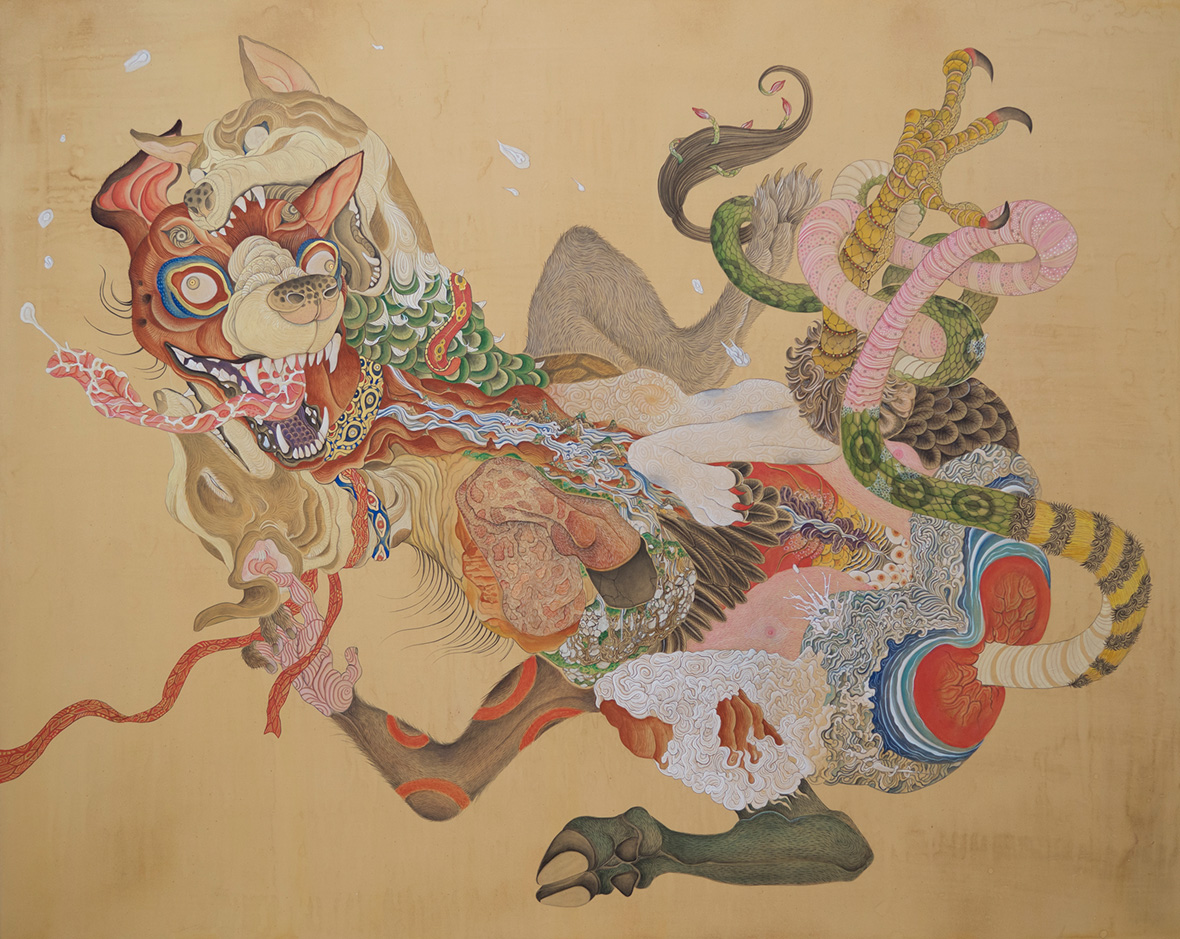
Other Japanese chimeras predate the Kotobuki, including the Nue and the Baku. The Kirin even has roots in China stretching all the way back to at least the year 200. Her style of painted animal—with slinking, wavy bodies, and bulging, cartoonish eyes—can be found in East Asian art as far back as the 1200s, although it’s unclear where exactly they originated. She says that by combining different animals as one, she’s able to “depict the relationships between them, ranging from enmity, cooperation, and indifference as they coexist.”
在“Kotobuki”之前,其他的日本奇美拉式神兽还包括鵺(Nue)和梦枕貘(Baku),还有起源于中国、有着至少 200 年历史的麒麟。她的彩绘动物有着起伏的身体和鼓突的卡通眼睛。虽然不确定确切的起源,但这样的绘画风格在 13 世纪的东亚艺术中便已存在。她说,将不同的动物特征合而为一,可以“描述它们之间的关系,包括敌对、合作和冷漠。”
In some paintings, feebee expands her menagerie to include animals outside of the Japanese zodiac, such as the piece that depicts a cat crushing a frog and a weasel under its paws. “It represents the unknown,” she explains. “It suggests the possibility of changing the cycle that has been repeating forever. A lot of things that no one had predicted have happened, and they’ve caused a lot of disruption to our norms and traditions. This represents a break from the cyclical flow of time represented by the zodiac. One way the cycle has certainly changed is that time has sped up because of the internet.”
feebee 有时还会画十二生肖之外的动物,譬如青蛙、黄鼬和猫。她解释说:“这些动物代表未知,暗示一直重复的循环也可能会被改变。许多人们没有预料到的事情发生了,打断了我们一贯的规范和传统,这正是十二生肖所代表的时间循环的中断。可能肯定的变化之一是时间似乎流逝得更快了,而原因就在于互联网的出现。”
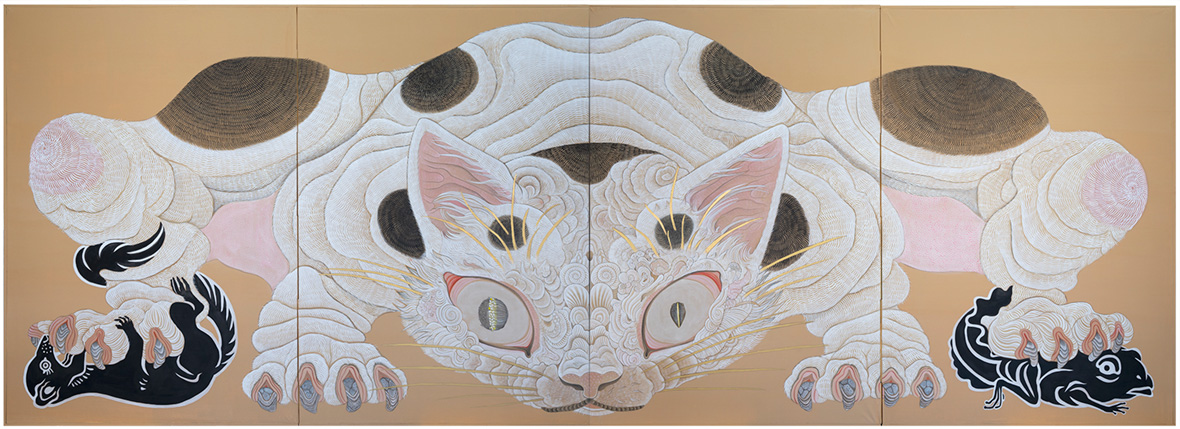
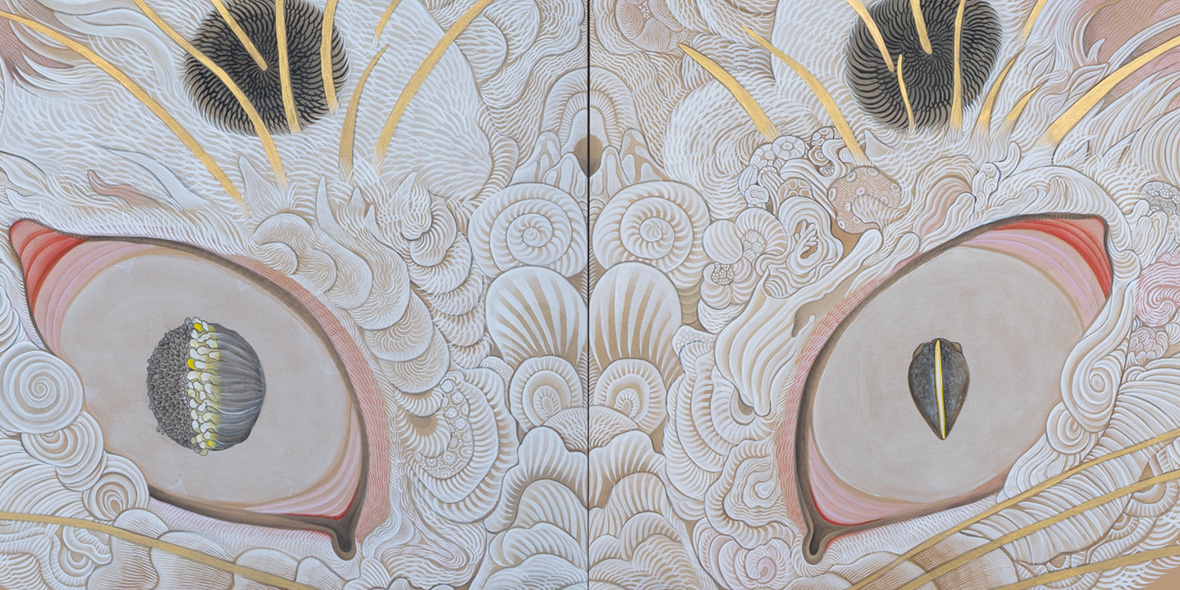
Her use of gold also builds on centuries of tradition. Gold leaf was first used in Japanese art to paint clay Buddhist sculptures in the 700s as an alternative to bronze sculptures. The use of gold in paintings was prominent by the 1200s as a way to present deities, Buddhist beings, and rays of light. Gold continued to be used in different ways in painting for centuries to come. feebee’s style of blending gold and earthy browns in the background grows out of that history. The way she places colorful characters on top of the gold can also be traced back to the 1400s, when a branch of Kanō school painters became known for using metallic colors as backgrounds for bright, polychromatic focal points.
除此之外,她在创作中对黄金的使用也源于流传数百年的传统。公元 700 年左右,金箔开始被用于日本艺术创作。当时人们用它来创作为黏土佛教雕塑,以替代青铜雕塑。到了 13 世纪,使用黄金绘画流行开来,黄金被用来描绘神灵、佛教形象以及各种光芒。在之后的几个世纪,黄金一直以不同的方式用于绘画创作,而 feebee 在背景中融合金色和土褐色的做法亦正是源于这段历史。她以金色作为色彩鲜艳的动物背景的做法,也可以追溯到 15 世纪。当时,日本狩猎画派(Kanō)的一部分画家以金属色为背景,搭配色彩缤纷的画像,并因此而为人熟知。
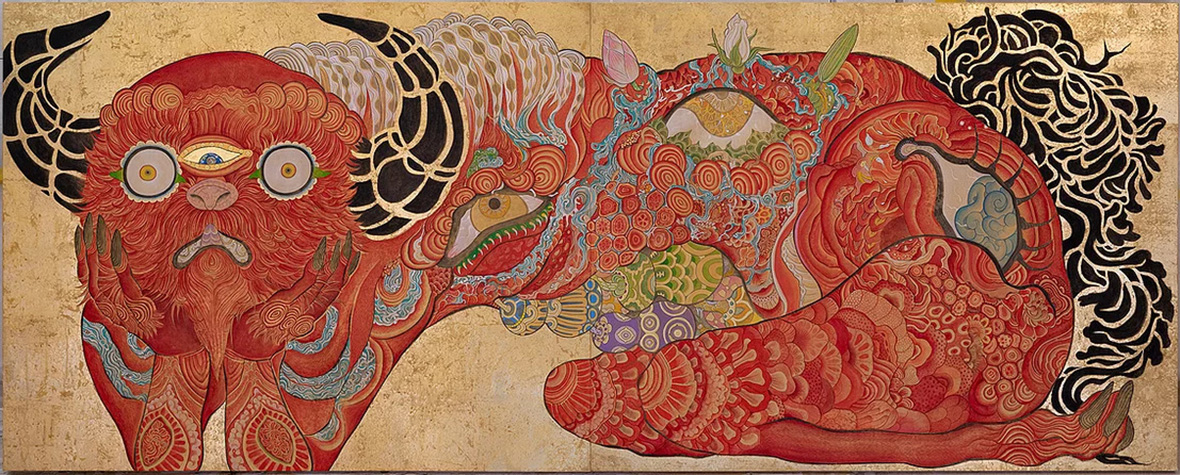
Buddhism first spread from India, making its way into China, Korea, and Japan, picking up new interpretations and incorporating local beliefs along the way. Different variations of the religion (and fluctuating degrees of Chinese and Korean influence) appear throughout the history of Japanese painting, although secular and domestic ideas also became prominent. The zodiac traveled with the Buddhists. Woodblock prints were also monopolized in Japan by Buddhists as a way to proselytize from the 800s until the 1600s when they started being used to bring art to the masses in the form of the ukiyo-e prints. Zodiac animals became common subject matter in ukiyo-e prints.
起源于印度的佛教,后来传入中国、韩国和日本,在这个过程中又不断获得新的诠释,并与当地的信仰相结合。纵观日本绘画历史,尽管世俗观念和日本当地信仰也很突出,但仍然能看到各种形式的佛教文化影响(取决于受到的中国和韩国文化影响程度)。十二生肖也随佛教文化一同传入。在日本,木刻版画几乎被佛教所垄断,在 800 年代到 1600 年代期间成为佛教的重要传播方式,以浮世绘版画的形式,向大众推广艺术。而十二生肖动物也成为了浮世绘中的常见元素。
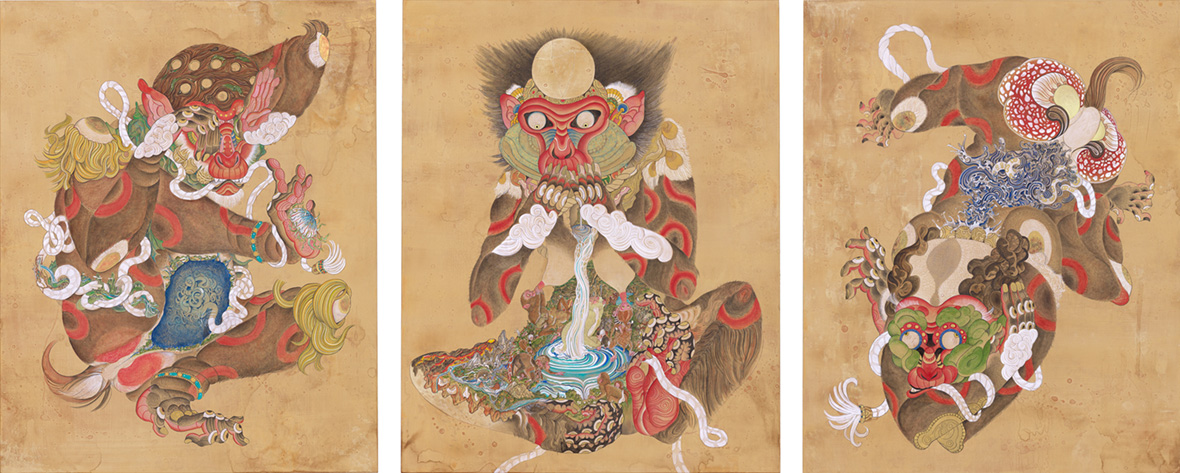
The ukiyo-e prints from the late 1800s, after a militarized Western presence had brought new techniques and ideas to Japanese painters—along with the era’s social upheaval—are major sources of inspiration for feebee, and she believes there are lessons that can be applied to the present day. “It was an era of rapid change and people were filled with new hopes and fears,” she says. “I think the current age we live in shares this tumultuous aspect.”
在 19 世纪后期,西方军国主义为日本画家带来了新技术和新想法。这个时期的浮世绘连同那个时代的社会动荡是 feebee 的重要灵感源泉。在她看来,现代人们也能从这段历史中借鉴一些经验教训。她说:“这是一个瞬息万变的时代,人们充满了新的希望和恐惧。我们现在所处的时代也同样动荡不安。”
Like our stories? Follow us on Facebook and Instagram.
Website: www.feebee.jp
Instagram: @feebeejp
Facebook: ~/feebeejp
Contributor: Mike Steyels
Chinese Translation: Olivia Li

